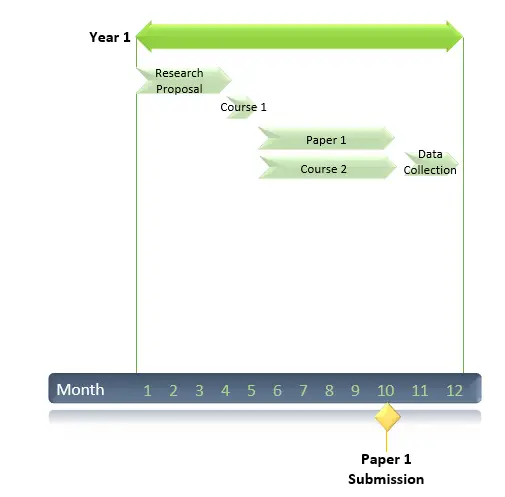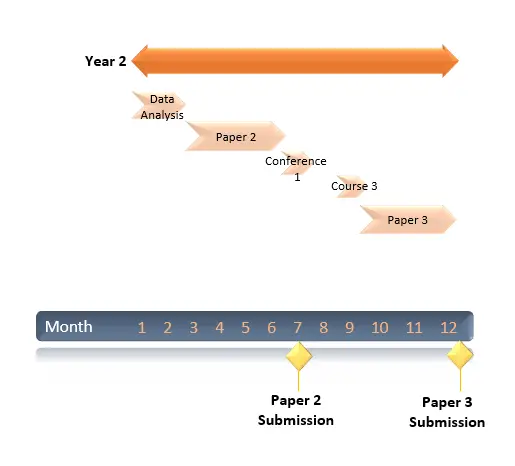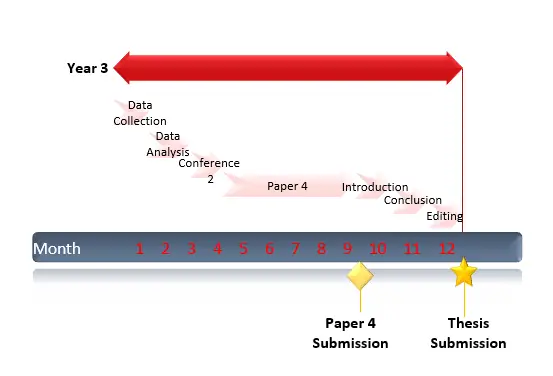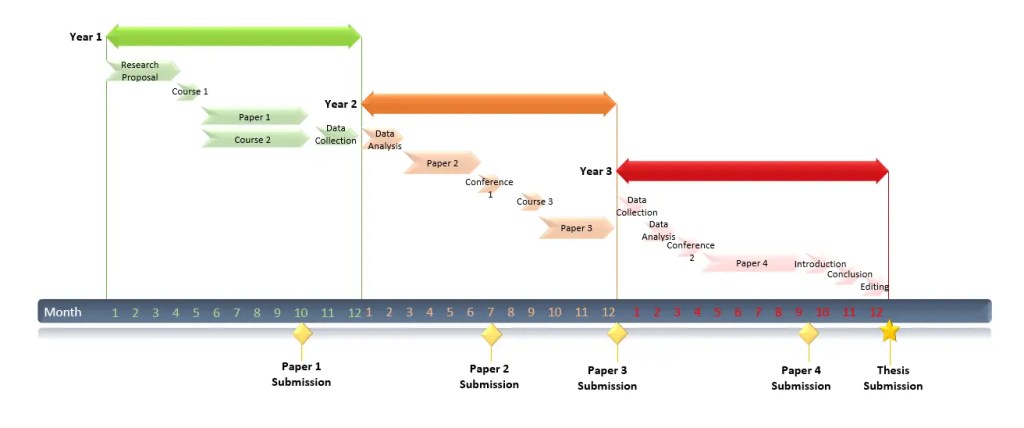
Planning out a PhD trajectory can be overwhelming. Example PhD timelines can make the task easier and inspire. The following PhD timeline example describes the process and milestones of completing a PhD within 3 years.
Contents
Elements to include in a 3-year PhD timeline
Every successful PhD project begins with a proper plan. Even if there is a high chance that not everything will work out as planned. Having a well-established timeline will keep your work on track.
What to include in a 3-year PhD timeline depends on the unique characteristics of a PhD project, specific university requirements, agreements with the supervisor/s and the PhD student’s career ambitions.
For instance, some PhD students write a monograph while others complete a PhD based on several journal publications. Both monographs and cumulative dissertations have advantages and disadvantages, and not all universities allow both formats. The thesis type influences the PhD timeline.
Furthermore, PhD students ideally engage in several different activities throughout a PhD trajectory, which link to their career objectives. Regardless of whether they want to pursue a career within or outside of academia. PhD students should create an all-round profile to increase their future chances in the labour market. Think, for example, of activities such as organising a seminar, engaging in public outreach or showcasing leadership in a small grant application.
The most common elements included in a 3-year PhD timeline are the following:
- Data collection (fieldwork, experiments, etc.)
- Data analysis
- Writing of different chapters, or a plan for journal publication
- Coursework
- Conferences
- Additional activities
The whole process is described in more detail in my post on how to develop an awesome PhD timeline step-by-step.
The example scenario: Completing a PhD in 3 years
Many (starting) PhD students look for examples of how to plan a PhD in 3 years. Therefore, let’s look at an example scenario of a fictional PhD student. Let’s call her Maria.
Maria is doing a PhD in Social Sciences at a university where it is customary to write a cumulative dissertation, meaning a PhD thesis based on journal publications. Maria’s university regulations require her to write four articles as part of her PhD. In order to graduate, one article has to be published in an international peer-reviewed journal. The other three have to be submitted.
Furthermore, Maria’s cumulative dissertation needs an introduction and conclusion chapter which frame the four individual journal articles, which form the thesis chapters.
In order to complete her PhD programme, Maria also needs to complete coursework and earn 15 credits, or ECTS in her case.
Maria likes the idea of doing a postdoc after her graduation. However, she is aware that the academic job market is tough and therefore wants to keep her options open. She could, for instance, imagine to work for a community or non-profit organisation. Therefore, she wants to place emphasis on collaborating with a community organisation during her PhD.
You may also like: Creating awesome Gantt charts for your PhD timeline
Example: planning year 1 of a 3-year PhD
Most PhD students start their first year with a rough idea, but not a well-worked out plan and timeline. Therefore, they usually begin with working on a more elaborate research proposal in the first months of their PhD. This is also the case for our example PhD student Maria.
- Months 1-4: Maria works on a detailed research proposal, defines her research methodology and breaks down her thesis into concrete tasks.
- Month 5: Maria follows a short intensive course in academic writing to improve her writing skills.
- Months 5-10: Maria works on her first journal paper, which is based on an extensive literature review of her research topic. At the end of Month 10, she submits the manuscript. At the same time, she follows a course connected to her research topic.
- Months 11-12: Maria does her data collection.

Example: Planning year 2 of a 3-year PhD
Maria completed her first round of data collection according to plan, and starts the second year of her PhD with a lot of material. In her second year, she will focus on turning this data into two journal articles.
- Months 1-2: Maria works on her data analysis.
- Months 3-7: Maria works on her second journal paper.
- Month 7: Maria attends her first conference, and presents the results of her literature-review paper.
- Month 8: Maria received ‘major revisions’ on her first manuscript submission, and implements the changes in Month 8 before resubmitting her first journal paper for publication.
- Month 9: Maria follows a course on research valorisation to learn strategies to increase the societal impact of her thesis.
- Months 9-12: Maria works on her third journal paper. She uses the same data that she collected for the previous paper, which is why she is able to complete the third manuscript a bit faster than the previous one.

Example: Planning year 3 of a 3-year PhD
Time flies, and Maria finds herself in the last year of her PhD. There is still a lot of work to be done, but she sticks to the plan and does her best to complete her PhD.
- Month 1: Maria starts a second round of data collection, this time in collaboration with a community organisation. Together, they develop and host several focus groups with Maria’s target audience.
- Month 2: Maria starts to analyse the material of the focus group and develops the argumentation for her fourth journal paper.
- Month 3: Maria presents the results of her second journal paper at an international conference. Furthermore, she helps out her supervisor with a grant application. They apply for funding to run a small project that is thematically connected to her PhD.
- Months 4-9: Maria writes her fourth and final journal article that is required for her PhD.
- Month 10: Maria writes her thesis introduction.
- Month 11: Maria works on her thesis conclusion.
- Month 12: Maria works on the final edits and proof-reading of her thesis before submitting it.

Example of a 3 year PhD Gantt chart timeline
Combining the 3-year planning for our example PhD student Maria, it results in the following PhD timeline:

Creating these PhD timelines, also called Gantt charts, is easy. You can find instructions and templates here.
Final reflection
Completing a PhD in 3 years is not an easy task. The example of our fictional PhD student Maria shows how packed her timeline is, and how little time there is for things to go wrong.
In fact, in real life, many PhD students spend four years full-time to complete a PhD based on four papers, instead of three. Some extend their studies even longer.
Furthermore, plan in some time for thesis editing, which is a legitimate practice and can bring your writing to the next level. Finding a reputable thesis editor can be challenging, so make sure you make an informed choice.
Finishing a PhD in 3 years is not impossible, but it surely is not easy. So be kind to yourself if things don’t work out entirely as planned, and make use of all the help you can get.



